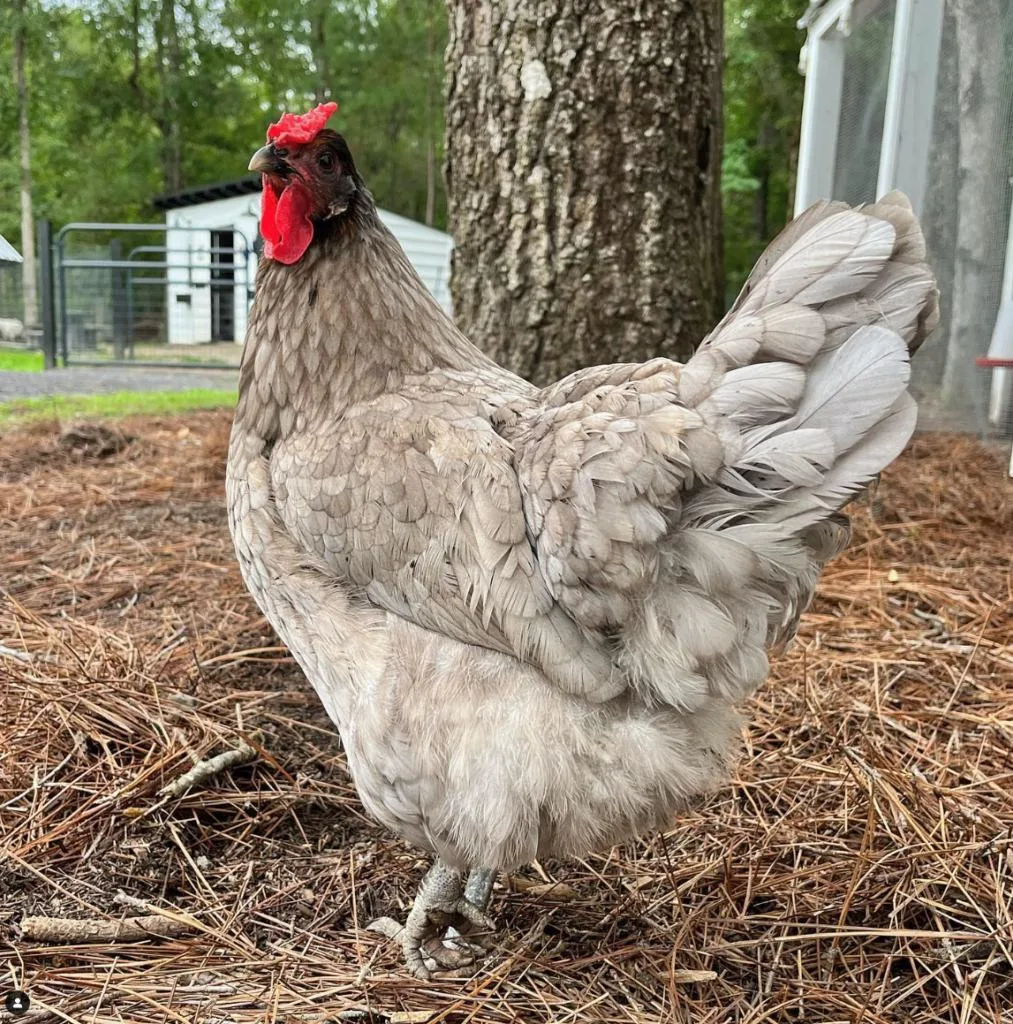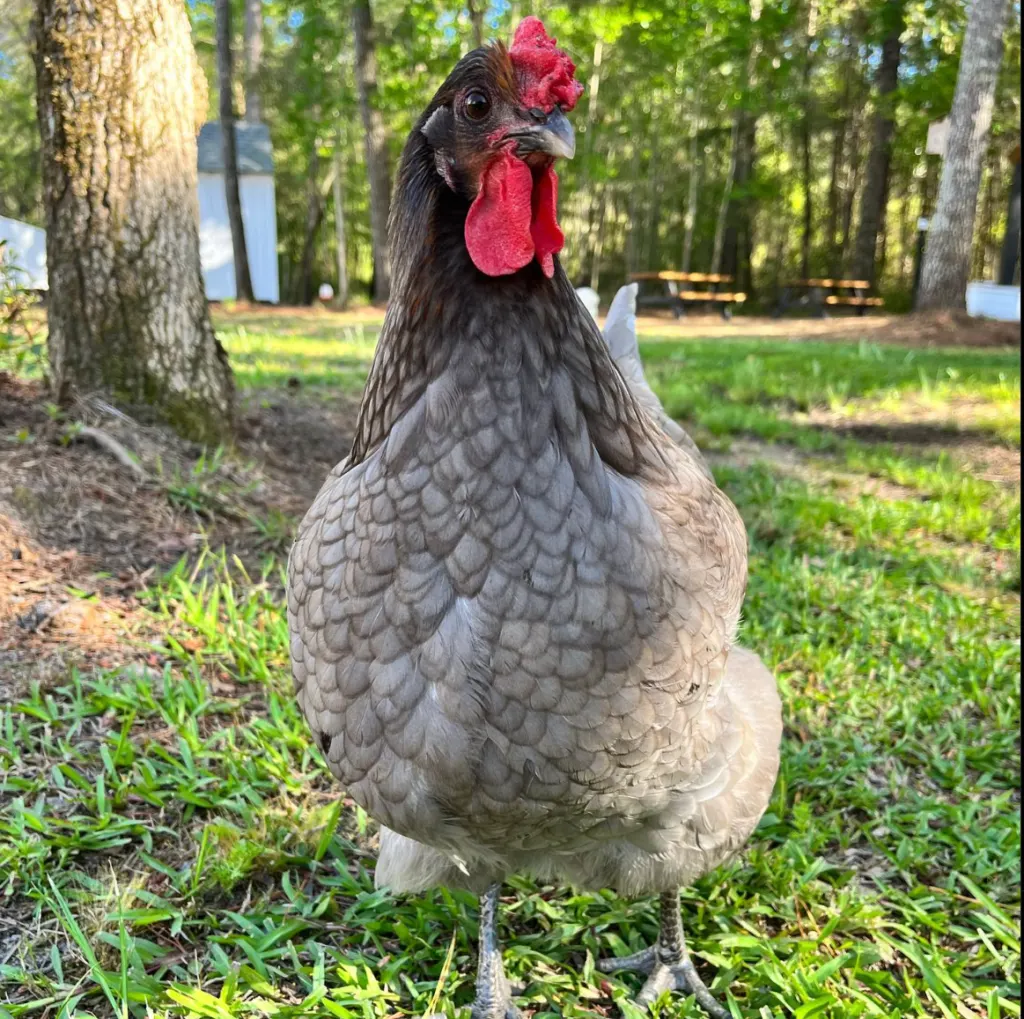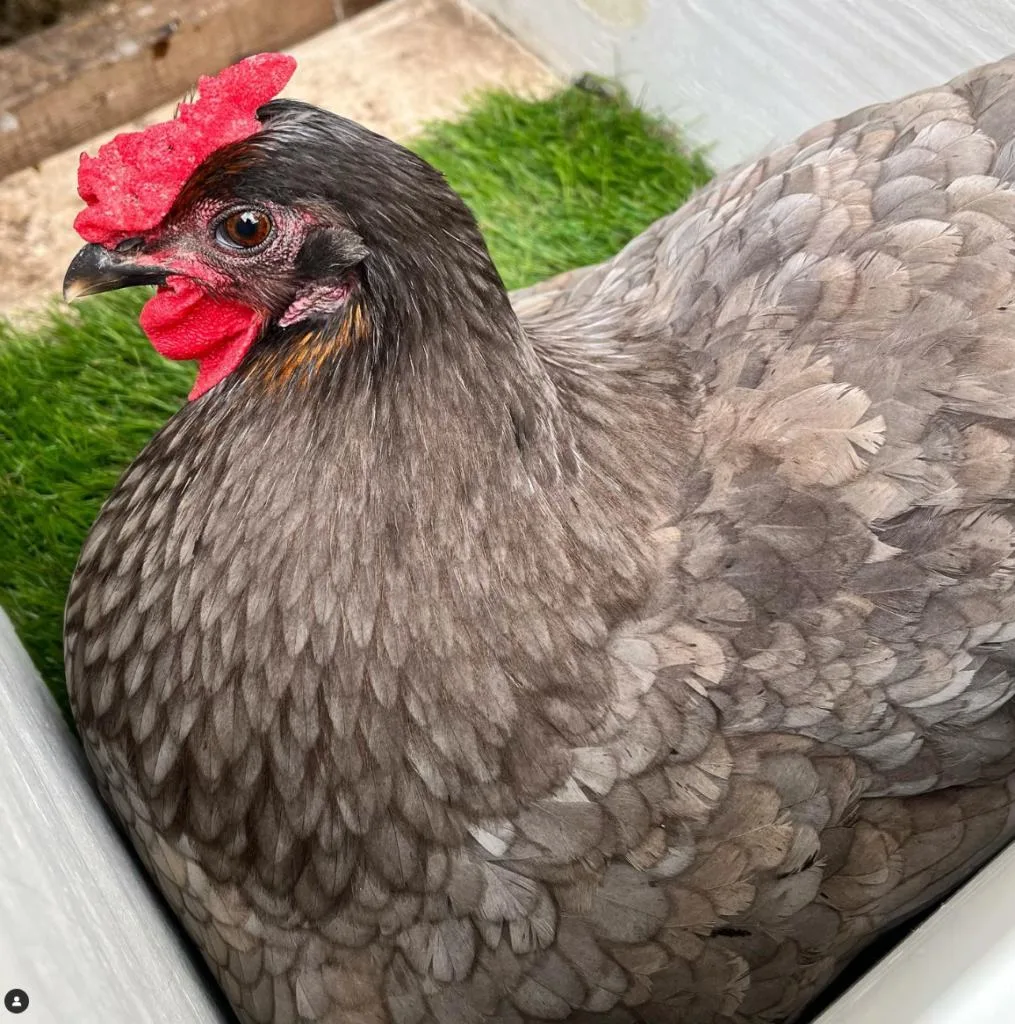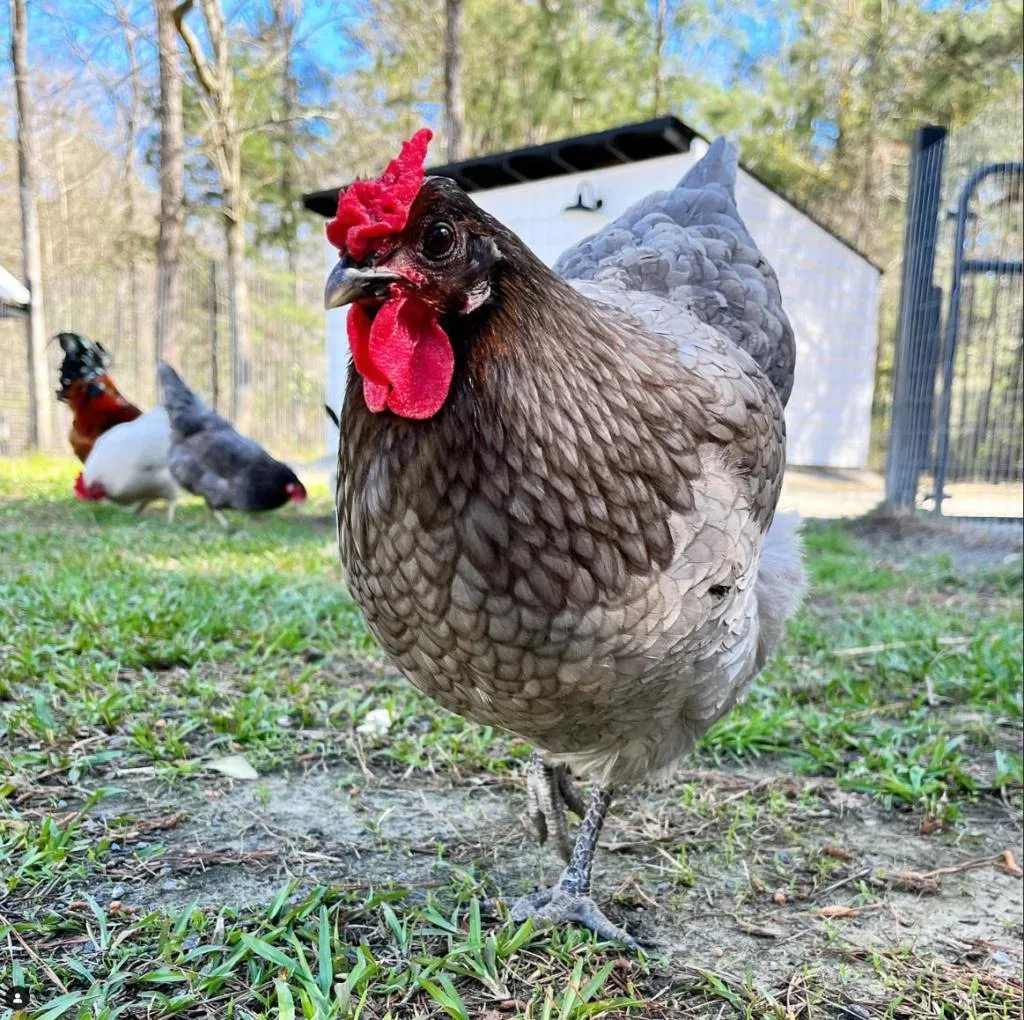Many chicken owners love to have colorful eggs on their counter and Sapphire Olive Egger eggs do not disappoint!
This chicken is known for their unique blue plumage and distinctive olive-colored eggs.
If you are interested in adding this lovely chicken to your flock, you’ve come to the right place.
In this article, we will discuss:
- What a Sapphire Olive Egger is and where they came from
- Sapphire Olive Egger appearance and temperament
- Breeding Sapphire Olive Eggers
- Some care tips and things to watch out for
- And some frequently asked questions

What is a Sapphire Olive Egger?
The Sapphire Olive Egger is a hybrid chicken that has been recently gaining popularity among backyard flock owners of all stages.
Created by Hoover’s Hatchery, this hardy and docile chicken is a great addition to any backyard flock.
Sapphire Olive Eggers are hybrid chickens that are a result of crossbreeding of various chicken breeds.
The parent breeds that contribute to the Sapphire Olive Egger’s unique characteristics are a chicken breed that produces blue eggs bred with a chicken breed that produces dark brown eggs.
The most common combination of breeds is an Ameraucana or an Araucana (Easter Egger), and a Sapphire Gem (Blue Plymouth Rock), which creates the Sapphire Olive Egger.
However, the specific breeds of chickens do not matter, as long as you breed a brown egg layer and a blue egg layer.
Because they are hybrid chickens, Sapphire Olive Eggers are not a classified breed.
Sapphire Olive Egger Overview
| Lifespan | About 8 years |
| Weight | Hen – 4 – 6 lbs, Rooster 6 – 7 lbs |
| Appearance | Dusty blue, gray, or lavender-colored feathers |
| Egg Color | Olive, however, colors may vary |
| Egg Size | Medium to large |
| Egg Production | Between 150-200 eggs per year (3-4 per week) |
| Broodiness Level | Varies |
| Beginner Friendly | Yes |
| Space Needed | 4 square feet inside the coop, 10 square feet outside |
| Price | $4 – $9 per chick |
Appearance
Because Sapphire Olive Eggers are hybrid chickens that are a result of mixing various chicken breeds, their appearance sometimes varies.
Generally, one of the most striking features of the Sapphire Olive Egger is their beautiful, smokey blue, gray, or even lavender plumage and distinctive tuft on their heads.
They have a medium-sized body with a broad, muscular back, and a single comb.
The Sapphire Olive Egger walks with an upright stature, making them appear tall and proud.
Sapphire Olive Egger hens typically weigh between 4 to 6 pounds at maturity, while roosters weigh between 6 to 7 pounds.

Egg Laying
The Sapphire Olive Egger is known for its egg-laying ability, producing eggs with stunning shades of green and olive.
However, they may not always produce green eggs.
Sapphire Olive Eggers are also known to lay dark brown, blue, or pink-colored eggs.
Hens will always lay the same color egg throughout her lifetime, though, and you won’t be able to tell what color egg she will lay until she starts actually laying.
They start laying their first eggs when they’re around five to six months old, and they can lay between 150-200 eggs per year, which is 3-4 eggs per week.
Their egg size is medium to large, with a weight of around 55-60 grams per egg.
Although their eggs come in a wide range of colors on the outside, they all taste the same and have the same nutritional value on the inside.
Sapphire Olive Egger Temperament
Sapphire Olive Eggers are hardy and docile chickens that make a great addition to any backyard flock.
They are typically friendly and easy to handle, making them an excellent choice for families with children and other pets.
They are also quite active and love to forage, so they require ample space to roam around.
With their adaptability to different climates, especially warmer ones, the Sapphire Olive Egger is a great choice for those living in various regions.
These chickens are often described as:
- Docile
- Friendly
- Active
- Nonaggressive
However, the temperament of each Sapphire Olive Egger can vary depending on the breeds of their parents.
Their level of broodiness also depends on the parent breeds.
If you are looking for a certain temperament for your Sapphire Olive Eggers, it is best to breed your own.
Here are some of the options for breeding Sapphire Olive Eggers:
Brown Egg Layers:
- Delawares
- Marans
- Sapphire Gem
- Welsimmers
- Barnevelder
Blue Egg Layers:
- Easter Egger
- Cream Legbar
- Araucanas
- Ameraucana
- Arkansas Blue

Breeding Sapphire Olive Eggers
Breeding your own Sapphire Olive Eggers can be tricky, only because they are a hybrid of two different breeds.
In order to properly breed a Sapphire Olive Egger, you will need to breed a brown egg layer with a blue egg layer.
There are also a few other things to keep in mind when breeding your own hybrid chickens.
Here are some tips on how to breed Sapphire Olive Eggers.
Selecting Breeding Stock
When selecting breeding stock for Sapphire Olive Eggers, it is important to choose birds that are healthy, active, and free from any deformities or defects.
Look for birds with good feather quality, a well-rounded body shape, and a friendly temperament.
It is also important to select birds that are good egg layers, as this trait is one of the defining characteristics of the Sapphire Olive Egger hybrid breed.
Breeding Process
Breeding Sapphire Olive Eggers involves crossing different breeds to produce a hybrid chicken that lays green or olive-colored eggs.
The exact breeding process will depend on the breeds used, but generally involves mating a rooster of one breed with hens of another breed that lay eggs of a different color.
To produce Sapphire Olive Eggers, breeders will typically cross a chicken that lays dark brown eggs with a chicken that lays blue eggs.
The resulting offspring will have a mix of blue and brown genes, which can produce green or olive-colored eggs.
It is important to note that not all offspring from these crosses will be Sapphire Olive Eggers.
Some may inherit more genes from one parent than the other, resulting in different egg colors or physical characteristics.
Breeders may need to selectively breed their birds over multiple generations to produce a consistent line of Sapphire Olive Eggers.
Breeding Sapphire Olive Eggers requires careful selection of breeding stock and a thorough understanding of genetics.
With the right breeding practices, however, it is possible to produce a healthy and productive flock of Sapphire Olive Eggers that will provide a unique and colorful addition to any backyard chicken coop.

Sapphire Olive Egger Care
Sapphire Olive Eggers are fairly easy to care for if they are given the right conditions.
They are also fairly hardy birds and will adapt well to different environments and temperatures.
Here are some tips on how to care for your Sapphire Olive Eggers:
Feeding
Just like with most chickens, Sapphire Olive Eggers require a balanced diet of mostly high-quality layer feed and plenty of fresh water.
They also do well with the occasional treat such as:
- Fruits
- Vegetables
- Mealworms
- Crushed eggshells
- Crushed oyster shells
- Chicken grit
- Seeds
- Other high-protein sources
It’s important to research any treat or table scrap before feeding it to your chickens to ensure that it is safe for them to consume.
They are able to eat fruits and vegetables (in moderation) such as:
- Watermelon
- Pinneaple
- Kiwi
- Plums
- Celery
- Green beans
- Berries
- Cucumber
- Leafy greens
- And more
Keep in mind that their diet should consist of mostly commercial feed with 10%-20% of their diet being treats and table scraps.
These birds also love to forage and will appreciate being able to free-range to get some additional vitamins and minerals.
Coop Setup and Care
Sapphire Olive Eggers should have adequate space and a proper coop setup in order to keep them happy and healthy.
Their coop size will depend on how many birds you are keeping and they each need plenty of space.
Overcrowding in their coop can lead to aggression, bullying, feather pecking, and the spreading of diseases.
Each adult Sapphire Olive Egger chicken will need 4 square feet of space inside the coop.
They also require perching space and nesting boxes (one nesting box per 4-5 hens).
If you plan to have them outside in a run, each chicken will require about 10 square feet of space.
It is important to ensure that their coop and run are secure and predator-proof to keep them protected at all times.
Free Ranging
Sapphire Olive Eggers love to free range and forage.
Just like with the run, each chicken requires at least 10 square feet of space while free ranging.
Health Concerns
Sapphire Olive Eggers are fairly healthy birds that typically resist most health issues and diseases.
The biggest health issue to watch out for is lice and mites. These are parasites that can spread quickly if not taken care of immediately.
Ensure that you are checking your birds regularly and cleaning out their coop often to avoid the spread of any parasites.
Diarrhea is another common symptom among all poultry.
If you notice this symptom, make sure that your birds have access to clean drinking water, which can help them to rehydrate.
It’s important to also make sure your chickens are not eating too many treats and are mostly fed their commercial feed.
If the diarrhea persists, contact your local veterinarian or professional.
Final Thoughts
Overall, the Sapphire Olive Egger is a beautiful and productive breed that offers a unique addition to any backyard flock.
With their hardiness, docile nature, and excellent egg-laying ability, it’s easy to see why they have become a popular choice among chicken enthusiasts.
They are a great addition to any backyard and are sure to bring joy to their owners with their colorful eggs and charming personalities.
Still want to learn more? Keep reading for some frequently asked questions.
FAQs
What is the difference between an Olive Egger and a Sapphire Olive Egger?
Olive Egger chickens come in all types of varieties, as they are all hybrids of mixing different breeds of chickens.
Sapphire Olive Egger chickens are a specific variety of Olive Egger chickens that come from breeding a blue egg layer and a brown egg layer.
At what age do Sapphire Olive Eggers start laying?
Sapphire Olive Eggers begin producing eggs when they are between 5 and 6 months old.
Once they start laying, they will lay up to 280 eggs per year, or 4-5 eggs per week.
Their egg production will slow down significantly after about 2 to 3 years.
Are Sapphire Olive Eggers good for meat production?
Sapphire Olive Eggers are not good for meat production as they are relatively small birds.
They are mostly kept for their egg-laying capabilities, however, the larger ones are sometimes used for meat.

